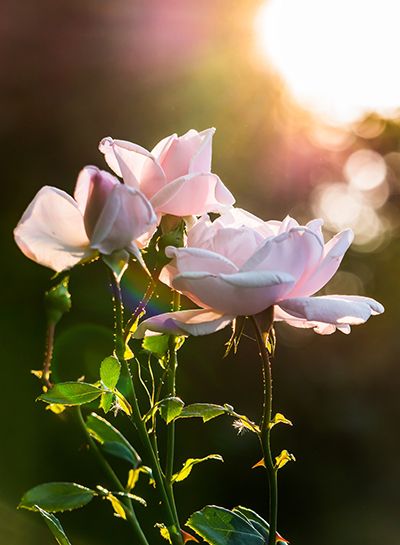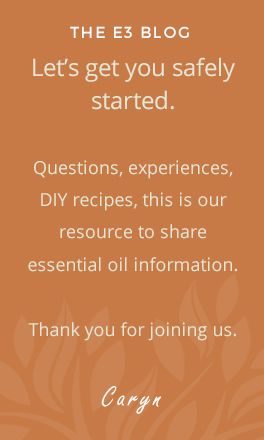No products in the cart.
Physical Wellness, Skin Care
How To Use Essential Oils For Rosacea
Written by e3 guest blogger: Joni Keim, Author & Educator
Joni has worked in the alternative health and wellness field for over thirty years as an author, practitioner, and educator. She is a licensed aesthetician and has certificates in aromatherapy, wholistic health sciences, and nutrition. Joni researches and writes for e3, provides technical direction for skin care, and assists in product development. Today she shares how to use essential oils for Rosacea.
What is Rosacea
Rosacea is a chronic disorder of the skin that occurs on the face, causing inflammation and redness on the cheeks, nose, chin, eyelids, and/or forehead. Skin affected by rosacea is sensitive and easily irritated. There may be swelling and a burning or stinging sensation. Blood vessels may become larger and more visible, and small bumps or pimples may appear. When associated with blemishes, it is often called acne rosacea, a form of adult acne.
The cause of rosacea is not known. It is so common that some dermatologists identify it as another skin ‘type.’ Symptoms may develop slowly over years or may develop quickly. Rosacea is more likely to appear in people between the ages of thirty and fifty, those with fair skin (especially with Celtic or Northern European ancestry), and those who blush easily. It affects about twice as many women than men.
Rosacea can be aggravated by a variety of things and may differ from person to person. Common aggravators are vigorous exercise, overexposure to the sun, exposure to extreme temperatures (both heat and cold), hot flashes, spicy foods, hot drinks, caffeinated drinks, alcoholic beverages, and stress. It can also flare up for no particular reason.
Though there is no known cure, the triggers that make rosacea worse can be avoided and a lifestyle and skin care program can be adopted that eases the symptoms.
Lifestyle Considerations if You Have Rosacea
Avoid the particular triggers that flare up your rosacea. They are specific to you, but they will likely include some of those listed above.
To help identify your triggers, keep a diary of activities, situations, and food that you suspect. Make a dated note of your flare-ups, and what you think may have caused them. When you notice a repeat of cause and effect, you should discover what you need to avoid.
You may want to try an anti-inflammatory diet, as rosacea is an inflamed condition. Primarily, this diet consists mostly of fruit, vegetables, and whole grains; some olive oil, seafood, yogurt, low fat cheeses, eggs, and lean meats; and little or no sugar, alcohol, red meat, processed foods, white flour products, butter, and chips. It may be helpful to discuss nutritional approaches for rosacea with your health care practitioner.
Certain vitamins can have an anti-inflammatory effect, such as vitamins A, B6, C, D, and K. Other supplements can reduce inflammation as well, such as fish oil (Omega 3), ginger, and turmeric. There are also products that have combined anti-inflammatory ingredients. Probiotics may be helpful for you, as they establish and maintain healthy flora in the intestines. Drink plenty of water to keep yourself hydrated, as dry skin tends to irritate more easily.
A Suggested Skin Care Program if You Have Rosacea
If you have rosacea, you have sensitive skin and it is important to treat your skin gently.
- Avoid products with known irritants. This includes ingredients such as, alcohol, menthol, glycolic acid, alpha hydroxy acids, sodium laurel sulfate, and synthetic fragrances, and color. Even certain natural ingredients can be too strong, i.e. essential oils of cinnamon, oregano, and thyme.
- Avoid soap and products that contain surfactants because they strip the skin’s natural, protective oils.
- Avoid any product that causes a tingling or stinging sensation. If you have blemishes, most products designed for acne are too strong.
- Avoid anything that is abrasive such as scrubs (which can contain abrasives made from ground walnut shells or pumice), loofahs or rough washcloths on your face.
- Use tepid water on your face—not too hot and not too cold.
- Use products that are gentle and designed for sensitive skin. Some products designed for children or babies may be useful to you. But you will only know if a product works well for you by using it.
Remember when you wash your hair in the shower to protect your face. Shampoo suds can irritate and flare-up rosacea. Before you get into the shower, put a small amount of olive oil, jojoba oil, or fractionated coconut oil on your face. Shampoo and rinse your hair with your head back, so suds do not run down your face. After your hair is thoroughly rinsed, rinse your face well to be sure all of the shampoo residue is removed. The oil that you have applied to your skin before shampooing, after rinsing well, will leave your skin feeling smooth and soft. It will not feel oily and should not irritate your skin.
Cleansing
Cleansing can be irritating to your skin, so, use a mild cleanser and be gentle. Choose a product that is free of foaming ingredients (surfactants), synthetic fragrances, and synthetic colors. If your face is especially dry and you don’t wear makeup, simply rinse your face well with tepid water. If you wear make-up, you will likely need some type of cleanser to remove it. Cleansing milks are creamy, gentle, and rinse well. (However, they do not remove waterproof mascara well. You may need a special product designed for that.) e3 Lotion can be used as a creamy cleanser, and though not designed for this purpose, it works well. You can also use a small amount olive oil or fractionated coconut oil as cleansers. Use your cleanser by applying a small amount and gently massaging your skin. Do not over cleanse. After cleansing, rinse very well with tepid water to be sure all the cleanser is removed. After rinsing, pat dry and then apply your moisturizer. Cleanse your face only one time a day, at night. In the morning, simply rinse with warm water, pat dry, and apply your moisturizer.
Moisturizing
Moisturizing your skin is important to prevent dryness. As mentioned before, dry skin is more apt to become irritated. Rosacea, even with blemishes, is usually not aggravated by oil but if yours is, use an oil-free moisturizer. Be sure your moisturizer is designed for sensitive skin. It should be free of synthetic fragrances and color. Look for a product that has a few simple ingredients. e3’s Honey Almond Cream and All Natural Lotions are good choices. Dr. Hauschka makes a Rose Cream that could work well. Always moisturize your face after washing it and after a bath or shower.
Sunscreen
Because sun exposure can aggravate rosacea, using a sunscreen should be part of your routine when you are going to be exposed to sun. Aside from helping to prevent flare-ups, sunscreens help prevent premature aging of your skin. Chemical sunscreens may prove to be too irritating, so your best choices are ones made with zinc oxide. Zinc oxide is a mineral and can be drying to the skin, so the product must be well formulated to counteract this. One of our favorites is DeVita Natural Skin Care’s Solar Protective Moisturizer 30+. Sometimes even the best sunscreen will irritate dry, sensitive skin. So, wear a sunscreen only when you need it—when you know you will be in the sun. If you are going to be in the house, there is no need. With rosacea, you want to avoid putting anything on your skin that isn’t necessary.
The Best Essential Oils for Rosacea
Essential oils with cooling, anti-inflammatory properties can offer a solution to calming the symptoms of rosacea, including swelling, redness, and itching.
Chamomile, Roman Anthemis nobilis: Anti-inflammatory, cooling, soothing, calms redness, calms itching.
Chamomile, German Matricaria chamomilla: Anti-inflammatory, cooling, soothing, calms redness, calms itching.
Helichrysum Helichrysum italicum: Anti-inflammatory, cooling, promotes healing.
Lavender Lavandula angustifolia: Anti-inflammatory, cooling, promotes healing.
Rose Rosa damascena: Anti-inflammatory, cooling, soothing, may reduce enlarged capillaries.
Sandalwood Blend: Anti-inflammatory, cooling, soothing, may reduce enlarged capillaries.
Recipes and applications of essential oils for Rosacea
From Practical Aromatherapy for Self Care by Joni Keim
Formula 1:
1 drop Helichrysum
1 drop German Chamomile
1 tsp *Tamanu carrier oil
Mix together well and store in small glass bottle.
Application: Gently apply—do not rub. Apply 3 times per day for a week, then 2 times a day for a week then 1 time a day for a week. This blend helps to calm your skin and reduce the inflammation and redness. When and how you apply it is up to you. Some people apply it under their moisturizer, some apply it over their moisturizer, and others mix it into their moisturizer.
Options: Add ¼ tsp of Aloe Vera to the blend. **Jojoba Simmondsia chinensis or ***Rosehip Seed oil Rosa mosqueta can be used instead of *Tamanu Calophyllum inophyllum.
Formula 2:
2 drops Helichrysum
1 drops Lavender
3 drops German Chamomile
1 tsp *Tamanu carrier oil
This is a stronger formula than Formula 1. If your skin is very sensitive, it may be too strong. Mix together well and store in small glass bottle. Use same application process as above.
*Tamanu Calophyllum inophyllum has been used extensively in hospitals in Europe, Asia and the Pacific Islands, as it is known for its ability to help heal wounds, fight infection, reduce inflammation, and promote healthy tissue formation.
**Jojoba Simmondsia chinensis is a wax ester and closely resembles the skin’s natural sebum. It is emollient, non- irritating, and helps to reduce trans-epidermal water loss, helping to keep skin moist.
***Rosehip Seed oil Rosa mosqueta has a high concentration of the essential fatty acid, GLA, which is necessary for the formation and maintenance of healthy cellular membranes through which nutrients pass into the cells. Rosehip Seed oil also helps to regulate sebum production and has antiseptic properties.
Essential oils for stress reduction
Stress can be a trigger for rosacea flareups, essential oils can help to reduce stress and promote emotional balance.
Single Oil Recommendations: Chamomile Roman Anthemis nobilis, Clary Sage Salvia sclarea, Frankincense Boswellia frereana, Lavender Lavandula angustifolia, Neroli Citrus aurantium, Rose Rosa damascena
E3 Synergy Blend Recommendations: Meditate, Serenity, Stress Relief, Relax, Sandalwood
Applications
Diffusion: Follow the diffuser manufacturer’s instructions to fill the air with soothing aromas
Inhalation: Put 1-3 drops of essential oil or blend on a tissue or cotton ball and inhale. (Avoid touching your nose with the tissue or cotton ball.) Tuck the tissue in a shirt pocket or undergarments for all day aroma.
Body Lotion: Add 3-6 drops of essential oil or blend to 1 oz of all natural, fragrance free moisturizing lotion. Apply to your skin, especially after a shower or bath.
Massage: Full body massage with stress relieving essential oils is a wonderful way to ease tension, assist the body with detoxification and increase a general sense of well being. Mix 6-12 drops of essential oil or blend in 1 ounce of carrier oil or all natural, fragrance free lotion.
Room Spritzer: Mix 25-30 drops essential oil or blend with filtered water in a 1oz spritzer bottle. Shake well before each use and avoid getting into the eyes.
Hydrosols: When plant material is steam distilled for aromatherapy, it produces both an essential oil and a hydrosol (the watery part). Hydrosols are gentle and considered excellent toners for skin care. Misting your face with Helichrysum, Chamomile, or Rose hydrosol may be helpful for your rosacea.
E3 does not sell hydrosols but they are available. We recommend Morning Myst Botanicals www.morningmystbotanicals.com.
Additional suggestions
See a dermatologist
Depending on how bad your rosacea is, and if none of these suggestions work for you, you may need to see a dermatologist. There are always medical advances and there may be something new that could be helpful.
Look for a dermatologist that will work with you in a holistic way and avoid antibiotics, if possible.
Calming zinc soap
Calming Zinc Soap (also known as Noble Formula) has been recommended by dermatologists as a cleanser for people with eczema, psoriasis, and seborrheic dermatitis. Some people with rosacea have found it helpful, so you may want to give it try. (Ingredients: saponified olive oil infused with calendula, saponified emu oil, ground oatmeal, 2% pyrithione zinc.) It is an anti-fungal and anti-bacterial soap.
Is Rosacea caused by skin mites?
Currently, no one really knows the cause of rosacea. Dr. Kevin Kavanagh, a biologist in Ireland, and his team began suspecting bacteria might cause rosacea and began searching for what it might be.
Demodex mites live on the skin of 20% to 80% of adults, feeding off the skin oil. They cannot be seen by the naked eye. In people with rosacea, there are 10 times more mites present than on people who do not have rosacea. Kavanagh says that changes in the skin due to age, stress, or illness can allow an overgrowth of the mites to occur.
When the mites die, they leave behind bacteria. The bacteria trigger an immune response that causes inflammation. “The mites themselves don’t seem to be harmful. It’s the bacteria they have inside their bodies.”
It is still just a theory as to whether the mite’s bacteria cause rosacea. Kavanagh says there is still more research needed.
Would you like to learn more about essential oils – like where they come from, how they’re made and how to make your own special blends? Simply download our free ebook, Listen to Your Nose – An Introduction to Aromatherapy.








